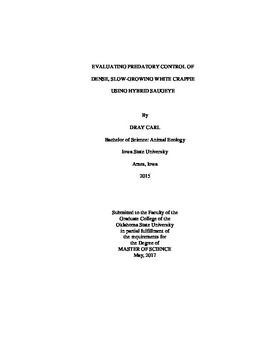| dc.description.abstract | White Crappie Pomoxis annularis is an important sportfish throughout the U.S., but this species notoriously forms "stunted" (high-density, slow-growth) populations. Fishery managers have used a predatory-control strategy of stocking saugeye Sander vitreum x Sander canadense in an attempt to help improve crappie population size structure for anglers seeking larger crappie for recreation or harvest. Saugeye are hypothesized to consume small White Crappie thereby directly reducing crappie population density, indirectly relieving intraspecific competition within the population, and ultimately improving individual crappie growth rates. However, among Oklahoma reservoirs, this management strategy has not consistently improved White Crappie population size structure. Therefore, my research evaluated the overall ability of saugeye introductions to improve growth and size structure of White Crappie populations and evaluated biological mechanisms that might explain variation in management outcomes. I combined White Crappie samples from saugeye-stocked and unstocked lakes in a before-after-control-impact (BACI) design and found that stocked lakes had significantly larger increases in White Crappie size structure and growth than control lakes. However, variation of population demographics increased after saugeye stockings, suggesting some lakes responded better than others. Therefore, I conducted a saugeye diet study (six Oklahoma reservoirs), which revealed saugeye diets varied among lakes, seasons, and saugeye sizes, with consumption of crappie as high as 20-40% by weight for large saugeye (> 460 mm) in summer or fall in some lakes. This observed lake-to-lake variation in saugeye consumption of White Crappie may explain the variable efficacy of this management strategy. I integrated crappie consumption rates from saugeye bioenergetics models into White Crappie population models to explore the biological mechanisms underlying the predatory-control strategy. Predation mortality focused on a narrow range of crappie lengths, and therefore had large population-level effects on White Crappie biomass and growth. Size structure of White Crappie populations was dependent on initial population densities and mortality, and my models fit observed field data well. Overall, growth and size structure improvements were greatest in systems with high initial White Crappie densities, but improvements also had limitations, as biotic interactions are not the only factors shaping White Crappie population dynamics in southern reservoirs. | |
